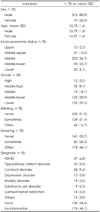Abstract
Objectives
The purpose of this study is to evaluate the effects of a cognitive behavioral therapy (CBT)-based school bullying prevention program for the adolescent perpetrators of school violence.
Methods
total of 395 middle and high school students (male=316, female=79) were included in this study. The changes after the program were evaluated using several self-rating scales for the assessment of the degree of depression, loneliness, impulsivity, self-esteem, and interpersonal reactivity compared with the baseline scales.
Results
The school bullying prevention program significantly reduced the degree of depression severity (t=5.985, p<0.001) and increased the self-esteem (t=-2.67, p=0.008) of the teenagers. This tendency was more pronounced among those teenagers under the age of 16. In the participants with high impulsivity or low empathy at baseline, the impulsivity scale decreased (t=2.617, p=0.009), while the interpersonal reactivity scale increased (t=-3.364, p=0.001) after the program.
Figures and Tables
Table 2
Changes in depression, loneliness, impulsivity, self-esteem and interpersonal reactivity scales after school bullying prevention program in subjects

Table 5
Changes in scales after the program in a group with high impulsiveness and in another group with low empathy

References
1. Lee SH. Revised contents and improvements of the act on the prevention and countermeasures against violence in schools. Korean Criminol Rev. 2012; 90:157–190.
2. Hong JK. A study on the status, cause and countermeasure of school violence. Korean J Elem Couns. 2012; 11:237–259.
3. Kim YS, Koh YJ, Leventhal BL. Prevalence of school bullying in Korean middle school students. Arch Pediatr Adolesc Med. 2004; 158:737–741.

4. Koo HJ, Kwak KJ, Smith PK. Victimization in Korean schools: the nature, incidence, and distinctive features of Korean bullying or wang-ta. J Sch Violence. 2008; 7:119–139.

5. Sigurdson JF, Undheim AM, Wallander JL, Lydersen S, Sund AM. The long-term effects of being bullied or a bully in adolescence on externalizing and internalizing mental health problems in adulthood. Child Adolesc Psychiatry Ment Health. 2015; 9:42.

6. Copeland WE, Wolke D, Angold A, Costello EJ. Adult psychiatric outcomes of bullying and being bullied by peers in childhood and adolescence. JAMA Psychiatry. 2013; 70:419–426.

7. Olweus D. Bullying at school: basic facts and effects of a school based intervention program. J Child Psychol Psychiatry. 1994; 35:1171–1190.

8. Dake JA, Price JH, Telljohann SK, Funk JB. Teacher perceptions and practices regarding school bullying prevention. J Sch Health. 2003; 73:347–355.

9. Salmivalli C, Nieminen E. Proactive and reactive aggression among school bullies, victims, and bully-victims. Aggress Behav. 2002; 28:30–44.

10. Heo YJ. A study on the experiences of school violence survivors: of those in their 30s and 40s [dissertation]. Seoul: Soongsil Univ.;2014.
11. Kim SH. A study on the teachers and students' awareness of school violence prevention [dissertation]. Seoul: Catholic Univ.;2005.
12. Lee JK, Chin TW, Cho JY. A study on the anxiety, depression, repression and coping strategy of delinquent adolescent. J Korean Neuropsychiatr Assoc. 1998; 37:493–500.
13. Vazsonyi AT, Belliston LM, Flannery DJ. Evaluation of a school-based, universal violence prevention program: low-, medium-, and high-risk children. Youth Violence Juv Justice. 2004; 2:185–206.
14. Kim HS, Han MK, Cheon SM. The development and effects of group counseling program for middle school students offered school violence. J Eval Couns. 2010; 3:47–57.
15. Kim JY, Jung JS. The effect of a group counseling program for the prevention of recurrent school violence behavior among middle school students. Korean J Youth Stud. 2011; 18:141–159.
16. Yoon CH, Park SG, Shin IS. A meta-analysis of the effects of school violence prevention programs in Korea. Asian J Educ. 2014; 15:189–215.
17. Kovacs M. The Children's Depression, Inventory (CDI). Psychopharmacol Bull. 1985; 21:995–998.
18. Cho SC, Lee YS. Development of the Korean form of the Kovacs' childeren's depression inventory. J Korean Neuropsychiatr Assoc. 1990; 29:943–956.
19. Russell D, Peplau LA, Ferguson ML. Developing a measure of loneliness. J Pers Assess. 1978; 42:290–294.

20. Kim KH, Kim JH. Korea UCLA loneliness scale. J Stud Guid. 1989; 16:13–30.
21. Barratt ES. Anxiety and impulsiveness related to psychomotor efficiency. Percept Mot Skills. 1959; 9:191–198.

22. Lee HS. Impulsivity test. Seoul: Korean Guidance;1992.
23. Rosenberg M. Society and the adolescent self-image. Princeton, NJ: Princeton University Press;1965.
24. Jeon BJ. Self-esteem: a test of its measurability. Yonsei Nonchong. 1974; 11:107–130.
25. Davis MH. A multidimensional approach to individual differences in empathy. JSAS Catalog of Selected Documents in Psychology. 1980; 10:85.
26. Park SH. Empathy and prosocial behavior. Seoul: Moonumsa;1997.
27. Kim J, Park C, Kim E. A study on violence around the school. Seoul: Korean Institute of Criminology Research;1997. p. 218.
28. Donnellan MB, Trzesniewski KH, Robins RW, Moffitt TE, Caspi A. Low self-esteem is related to aggression, antisocial behavior, and delinquency. Psychol Sci. 2005; 16:328–335.

29. Lee JL. The verification on effects of cognitive behavioral therapy program for early adolescent sexual assault offenders. Korean J Rehabil Psychol. 2014; 21:319–338.
30. Lee JS. The effect of the group program of cognitive-behavioral therapy on the impulsivity and empathy of juvenile delinquents [dissertation]. Daegu: Catholic University of Daegu;2010.
31. Sowell ER, Thompson PM, Holmes CJ, Jernigan TL, Toga AW. In vivo evidence for post-adolescent brain maturation in frontal and striatal regions. Nat Neurosci. 1999; 2:859–861.





 PDF
PDF ePub
ePub Citation
Citation Print
Print






 XML Download
XML Download